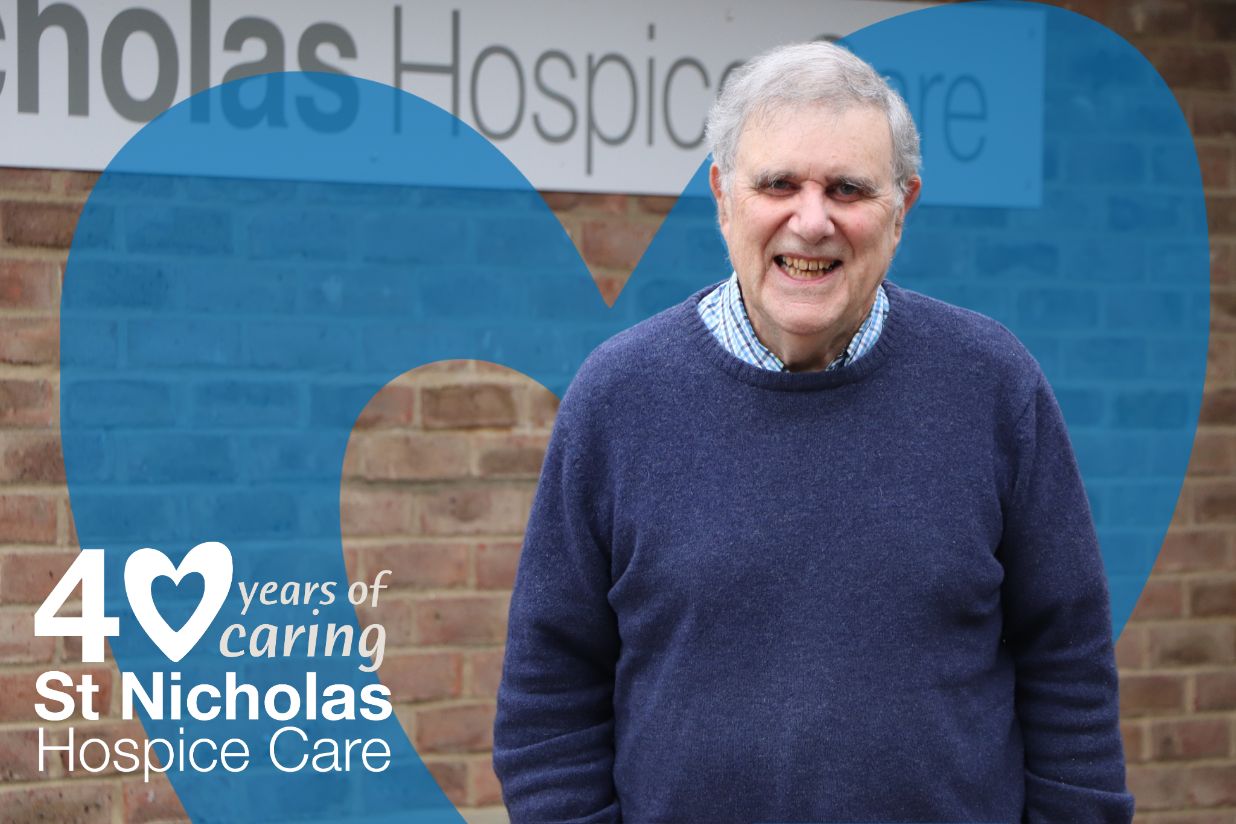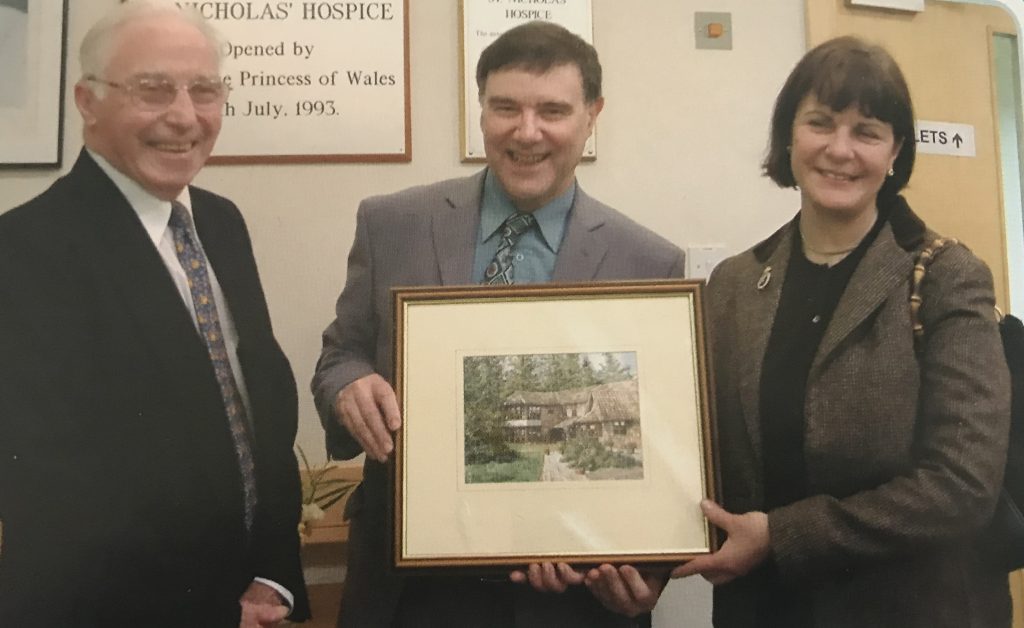Call our 24/7 advice line for health care professionals and families if you need support with symptom management and end of life care - 01284 766133.

Bob Jones
Bob joined the Hospice from West Suffolk Hospital in June 1993, having spent 20 years working there as a General Manager and Chief Executive, taking the hospital into Trust status.
“As soon as I was here, I knew I made the right decision.”
Bob arrived at St Nic’s shortly after the Hospice moved into its new building on the Hardwick Lane site, and he was among those who welcomed Princess Diana when the building was formally opened.
Bob recalls: “There was a real buzz about the place. This was the brand new Hospice that everybody had been waiting for – for some time.
“Sadly, my predecessor, Marie Deacon, died on the day that I arrived. So that added a tinge of sadness to my arrival, I must admit.
“Before Marie died, she asked me to come up and suggest any people that the Hospice might approach to succeed her. She knew she was going to have to leave.
“I walked away from that discussion and thought, ‘I wonder if that could be for me.’ I mean, in material terms, it was a very strange decision to make because I took a large pay cut to St Nicholas from the hospital. But as soon as I was here, I knew I made the right decision.”
“A lot of tender care.”
As is still the case, when Bob was CEO of the Hospice, the community raised the majority of the funds needed to ensure services and support could continue. With a newly opened in-patient unit, more money would be required, and he needed the NHS to agree to give St Nic’s more funding, which they did.
Bob adds: “I had to get used to a much different organisation. The hospital was vast. This place (the Hospice) was relatively small. But I realised that it was an organisation that needed a lot of tender care, and the people looking after people at very difficult times in their lives needed to be looked after.”
“She was a real dynamo.”
Being involved in the earlier years of the Hospice meant that Bob had the chance to work with some of the Hospice’s founders, who instigated the creation of St Nicholas Hospice Care.
Some of those important figures have since died, but the legacy they created all those years ago continues to develop.
Bob explains: “There was the irrepressible Lady Miriam (Hubbard), who had been drafted in from Riding for the Disabled to really boost the appeal for the new Hospice. She was a very eccentric lady. And used to sit out in the main office at a big desk raised from the ground.
“But she was a real dynamo. Not the kind of person I’d ever had to deal with before. So that was a challenge, but a really interesting challenge.
“Of course, there was Richard Norburn, who was like the founding father of the Hospice, who I’d known for several years anyway through local church connections.
“And I think, finally, my old boss at the hospital, John Melleney, who had very much taken the Hospice under his wing. And I think if it hadn’t been for him, it wouldn’t have made the progress that it did. He was the person who managed to get the site here (Hardwick Lane) and donated it to the Hospice.

“I think, over the years, he was somebody who was actually very important but probably not as well-known as some other people but vital to the success of the Hospice.”
When Lady Miriam died in an accident in 1996 at the age of 71, John took over as chairman for a number of years.
“At times, he said, ‘I’m only going to do it for a year until the charity finds somebody better.’ But then he continued for a long time. He was never a flashy showman, but he knew how organisations ticked and had a really wide range of contacts, which was very useful.
“When he retired, Clare Euston took over. And again, she was a very powerful and potent, but charming, chair as well,” added Bob.
“She looked genuinely shocked and said, ‘What are you going to do with all these people?’ So I said, ‘Feed them.’”
Within a few months of his arrival at St Nic’s, the Hospice celebrated the official opening of the Hospice building in Hardwick Lane. Bob and his team had a very important visitor to welcome – Princess Diana.
“I went to a presentation that Linda (current Hospice CEO) did last year when she was talking about the Hospice. She didn’t know I was going to be in the audience, and the first slide that she displayed was a picture of me and Princess Diana walking into the Bradbury Green area. So I was a bit chuffed by that, I must admit.”
It was all choreographed down to the last minute. Though, she did spend a lot more time in the in-patient unit than she was timetabled to do. And I can always remember that she was talking to an older man on his bed, and he had red braces on, and she pinged his braces. And I thought, well, that was just a lovely touch.
“As we walked into the Bradbury Green area, there was a huge crowd of people. And she looked genuinely shocked and said, ‘What are you going to do with all these people?’ So I said, ‘Feed them.’ It’s the first thing that came into my mind. But it was an absolutely lovely day.
“And, of course, with great sadness, she died a few years after that. I remember getting a call from one of the nurses on the in-patient unit about 8am on a Sunday morning to say that the press had been on to them about Princess Diana. I hadn’t heard that she’d been killed. And that was a huge shock. I can remember that still to this day, the shock I felt.”
“The Hospice is very much about the whole family.”
Providing holistic care that really focuses on the individual and their loved ones is something that remains at the heart of St Nic’s. The care and support we offer aren’t just for the person who is dying. We want to wrap our support around the whole family, which was an ambition when Bob was CEO and something he took away with him.
“The Hospice is very much about the whole family. It’s not just about a single patient. And it’s about providing the right care across people’s needs from diagnosis right through to bereavement care,” explains Bob.
He adds: “And I think it’s left me with the desire always to tell people what Hospice care is about. I still feel that some people deny themselves or their relatives deny them Hospice care because they don’t really understand what it means.
“So I think the Hospice and people who are associated with it have still got to relentlessly communicate what Hospice care is all about. So many people think it’s the death warrant place, but far from that.
It’s care for the whole person and the whole family. And I think it has affected how I relate to people. I think, hopefully, it’s given me a greater sensitivity to how to approach people in that situation.
Looking after the people doing the caring
During his almost 12 years at the Hospice, Bob oversaw a significant building extension. Works that were completed in 2001 included the ‘Ark,’ which housed the Hospice’s Nicky’s Way, a service for bereaved children and young people.
Other highlights include the installation of the stained glass window in the Hospice’s Place to Be (formally Chapel) and the appointment of a full-time chaplain.
Although Bob didn’t have any clinical experience, as his background was a managerial one, looking after staff and volunteers and creating an environment where they could flourish was something he wanted to do.
He explains: “It’s a very stressful job at times, and I think I saw my role as supporting the staff who were providing direct care and providing the environment in which they could prosper at the Hospice.”
“It’s the people.”
Bob adds: “It’s the people really. It’s the staff, the volunteers, the patients, that’s what I think I’ve been left with the biggest memory of, the lovely people that I’ve worked with.
“Like any organisation, it’s not always smooth sailing. It (the Hospice) had its problems and issues to deal with, and, of course, the person at the top was expected to sort all those things out. But on the whole, I left this place with lovely memories.”
“I’m proud of my time here.”
When the organisation bid a fond farewell to Bob on Friday, 28 January 2005, many people attended his leaving event.
The occasion was covered in the Hospice’s newsletter, where his old boss and our former Chairman and Trustee at the time, John Melleney, wrote: “Bob Jones leaves with all our best wishes and thanks for all he has achieved at St Nicholas Hospice. Not only has he been a much respected Chief Executive, but he has been a wonderful ambassador for our Hospice, both locally and nationally. He will be much missed.”
Living in the local area, Bob still keeps up-to-date with the Hospice and remembers his time at St Nic’s fondly.
He said: “I don’t lose any opportunity of promoting the Hospice, even though I’ve been away from it for many years.
“I’m still very proud of my time here. And I’m not saying I didn’t make any mistakes. I did. And did I have some difficult times? Yes, I did have some difficult times. But I went away feeling that I had done a good job here. And that was lovely.”
Love, love, love
When asked if he could describe the Hospice in three words, Bob replied: “I’m going to repeat the same: Love, love, love.”
Do you have a story about your connection with St Nicholas Hospice Care?
In our 40th year celebration, we want to highlight the many contributions in our Hospice’s history.
We’re aiming to proudly feature 40 faces across the year, could you be someone who has a story to share?
If you are someone who has a fond memory to share, you can do so here.
